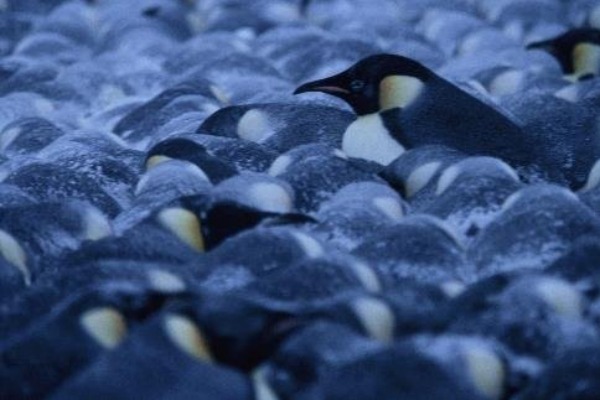Math Reveals Perfectly Cozy Penguin Huddles

Greed is good for penguins that huddle together to avoid Antarctica's icy weather.
According to a new study, penguin groups can maximize everyone's heat when individual birds act selfishly, huddling in ways that keep them toastiest.
"Even if penguins are only selfish, only trying to find the best spot for themselves and not thinking about their community, there is still equality in the amount of time that each penguin spends exposed to the wind," study researcher Francois Blanchette, a mathematician at the University of California, Merced, who normally studies fluid dynamics, said in a statement.
Blanchette became interested in penguin huddles after watching the hit documentary "The March of the Penguins." He and his colleagues made mathematical models of penguin huddles, varying wind strength and turbulence to see what sort of shapes arose. The model calculated which penguin along the edge of the huddle would be coldest and had that penguin move toward the center of the huddle in a sort of constant rotation.
These models produced long, thin huddles that gradually crept away from the wind direction. In real life, penguin huddles are more rotund, so researchers went about making their models more realistic. They added an element of uncertainty, such as wind eddies and differences in size of the huddled penguins. The result was huddles that look much like those seen on real Antarctic ice. [Album: The Penguins of Deception Island]
"A penguin huddle is a self-sufficient system in which the animals rely on each other for shelter, and I think that is what makes it fair," Blanchette said. An obstacle to the ideal shape, such as a wall, would likely make the huddles less fair, he added.
Blanchette and his mathematician colleagues report their work today (Nov. 16) in the journal PLOS ONE, and will present the findings at the American Physical Society's fluid dynamic conference next week in San Diego. They hope to get feedback from biologists on their findings. The model may also help biologists refine their observations of penguins in the field by letting them know what behaviors to look for in huddles.
Sign up for the Live Science daily newsletter now
Get the world’s most fascinating discoveries delivered straight to your inbox.
Blanchette also hopes the penguin study will help spread the word about his first love, math.
"Nearly everybody seems to love penguins, and not enough people love math," he said. "If we use math to study penguins, we could potentially teach more people to love math, too!"
Follow Stephanie Pappas on Twitter @sipappas or LiveScience @livescience. We're also on Facebook & Google+.

Stephanie Pappas is a contributing writer for Live Science, covering topics ranging from geoscience to archaeology to the human brain and behavior. She was previously a senior writer for Live Science but is now a freelancer based in Denver, Colorado, and regularly contributes to Scientific American and The Monitor, the monthly magazine of the American Psychological Association. Stephanie received a bachelor's degree in psychology from the University of South Carolina and a graduate certificate in science communication from the University of California, Santa Cruz.









